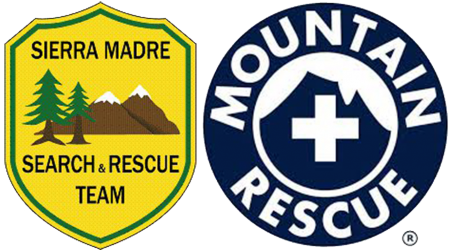Just after midnight on Saturday, May 15th the pagers of the Sierra Madre Search and Rescue Team (SMSR) went off. A dozen team members had just crawled into sleeping bags in Joshua Tree National Park after an all-day navigation exercise. They would respond to the call after a few hours of sleep, but team members who were in town immediately responded to assist Montrose Search and Rescue in the search for a missing hiker on Mt. Waterman.
The search effort continued for 4 days. On Wednesday, May 19th Dave Null was located by the Air Rescue 5 helicopter. He was alive and well, but deep in rugged terrain in Bear Canyon. He was far off track from the hike at Mt. Waterman that he’d started Saturday.
This was the third multi-day search near Mt. Waterman this spring. In March, Narineh Avakian’s body was found 6 days after she left for a day hike, and in April, Rene Compean spent an unexpected night out before being rescued.
They were lost.
All of these searchers were for lost hikers. None of these hikers were injured and immobilized. They hadn’t fallen down or gotten trapped at the bottom of a cliff. They were lost.
Without a basic map, even a simple unexpected trail intersection can get a hiker lost. And if a hiker loses the trail, strong navigation skills are needed to negotiate the San Gabriel Mountains. During the Null search, weather was a complicating factor. Clouds rolled up and down the Waterman drainages, wrapped around the peaks and rolled over ridges. One minute, searchers were in the sun, and the next minute, they’d be in a misty cloud bank.
Cloud cover like this can be very disorienting. It is easy to lose a sense of where you are when you cannot see any landmarks or the terrain around you. Even experienced field teams who are familiar with the area had to drop their packs during the search and spend time with their GPS and a map to verify their location and lock in a direction of travel on their compass.
Map and Compass
Members of SMSR carry a map, compass, GPS unit, and now often a phone with us at all times. While using Gaia or other apps on the phone can be very useful, we never rely on them (or their batteries) as our sole means of navigation. We do rely on the skills we’ve all tested at the Joshua Tree navigation exercise. At this exercise, team members use nothing more than a map and compass to navigate to a point on our map where we’ll find a small flag which has a clue for plotting our next point on the map. It is a difficult exercise, but it develops an essentials skill.
SMSR encourages you to prepare for your hikes by carrying a map and compass and knowing how to use them as well as your GPS or cell phone. Read articles in Outside magazine, listen to podcasts like The Sharp End, learn from more experienced friends, take a class at REI, or read books like Staying Found. But start by purchasing a map. Tom Harrison and National Geographic both put out good maps of our local mountains. Carry them with you. Open them up and practice using them.
Since 1951, the all-volunteer Sierra Madre Search and Rescue Team has responded to calls for help in the local mountains and beyond. Visit smsr.org to read more about how to prepare to head into the wilderness, learn about the Team, or donate.

